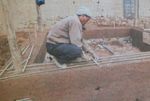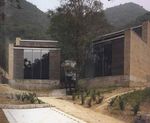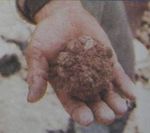REVIEW ON TECHNICS OF RAMMED EARTH WALL
←
→
Page content transcription
If your browser does not render page correctly, please read the page content below
International Workshop on Rammed Earth Materials and Sustainable Structures &
Hakka Tulou Forum 2011: Structures of Sustainability at
International Symposium on Innovation & Sustainability of Structures in Civil Engineering
Xiamen University, China, 2011
REVIEW ON TECHNICS OF RAMMED EARTH WALL
1 2
Chengbin Zhou and Yongning Liang
1
School of Architecture, Fuzhou University, Fuzhou, Fujian 350108, P.R. China
2
College of Civil Engineering, Fuzhou University, Fuzhou, Fujian 350108, P.R. China
zhouzhoubinbin@163.com
Abstract: Rammed earth building has wide prospects of exploitation and utilization in certain fields because of its advantages of
saving water and energy,but the research on the technics concerning declines, hence restricting its diffusion. Based on the review of
revolution history and contemporary practice, it is brought up that there is a need to carry on the optimization research of rammed
earth wall with modern technology from its prescription and mix proportion,additive and construction tools, etc, so as to gain its
reactivation and promotion of low-tech green buildings.
Keywords: Review, technics, rammed earth wall
1 INTRODUCTION
Being an important traditional material, rammed earth has a long history in China, and civil engineering is named as “earth & wood”
up to now. Rammed earth building is easy to obtain material from local sources with low cost, and the inner is warm in winter and
cool in summer, so it is widely used. With the diffusion of modern material, rammed earth buildings decrease, and its technics
stagnate, too. Nowadays, sustainable development has become the trend of the times, and the rammed earth buildings are faced with
new chances because of its advantages of saving water and energy as well as recycling. Hence the technics of rammed earth wall is
studied so as to advance this technique.
2 A PROFILE ON TRADITIONAL TECHNICS OF RAMMED EARTH WALL
It is said that Fuyue (Fig.1), who is in Yinshang Dynasty, created the construction technique of rammed earth wall which is named as
“Banzhu” (Zhang, 2006). After that, it is applied on city wall and palace. The technics has been used for several thousand years,
bringing about lots of local prescription according to the composition of the soil, also the tools (Fig.2) vary with different region.
Much attention is drawn to the control over thickness of each layer rammed earth and ratios of height to thickness of the whole wall.
In Ying Zao Fa Shi, an official building standard of Song Dynasty, there is the provision of “the order of rammed earth wall is to
enhance the height of wall nine inch when the thickness raises three”. The earth building in Fujian (Fig.3),which represents the
technics summit of rammed earth wall, has a ratio of height to thickness that reaches the striking level of 25:1.
Fig.1 Portrait of Fuyue Fig.2 The tools of rammed earth wall in west ChinaSingle Group
Fig.3 The typical earth buildings in Fujian
3 CONTEMPORARY PRACTICE AND PROGRESS
3.1 Official Force
As we all know, knowledge comes from practice. In recent years, there are some typical cases sponsored by different fields where we
can see the present situation of technics of rammed earth wall.
In 2008, after the earthquake in Panzhihua, Ministry of Housing and Urban-Rural Development of the People’s Republic of China
united with Wu Zhi Qiao (Bridge to China) Charitable Foundation of Hongkong published the construction atlas of rammed earth
rural house with seismic resistance in the reconstruction considering the local tradition of using rammed earth, which makes some
innovation and optimization on the composition and construction technology. It’s the only technics standard of rammed earth edited
under the leading force of government, which elaborates on the formwork, hammer, and earth to use in details (Fig.4) and
emphasizes the anti-seismic performance by bringing up some reinforced seismic resistance process especially (Fig.5).
Formwork Rammer Earth to use
Fig.4 The construction tool and earth standard
Horizontal Vertical
Fig.5 The seismic resistance process3.2 Folk Force
Constantly, the technics of rammed earth is often regarded as out-dated technology, so the folk force aimed at the attempts
of non-mainstream, and inheritance is more than innovation in the technics. Here are some cases.
3.2.1 Nonprofessional
Ren Weizhong, civil environmentalist of Anji county in Zhejiang province, designed and built ecological houses including one hotel
(Fig.6) and three little houses by himself, which has caused nationwide repercussions. The material used is an ordinary local tabia
with composition of earth, sand and white lime. (Among them, the earth and sand come from uncultivated soil under the allowance of
the government) The mix proportion is 5 :4 :1, and the porosities and strength are reasonable proved by the experiment (Wang and
Ma, 2008).
Fig.6 Rammed earth ecological hotel
3.2.2 Professional
Wangshu, a famous architect, built a small rammed house (Fig.7) in the park as a sculpture work with the technology innovation of
using steel formworkn (Li, 2001). But the technics is somewhat random, and the wall even collapsed. Another architect, Zhang
Yonghe, built “split house” with rammed earth at the foot of the great wall (Fig.8) (Ye and Zhang, 2002). These are the very few
conscious attempts of using rammed earth as building methods by the professional architect. After long time of fading out, we can
see that much more attention is drawn to the appearance than the technics of rammed earth, no doubt these cases show the feasibility
of revival under modern technology to the people.
Fig.7 “Sculptor” construction siteExterior Construction site
Fig.8 “Split House” construction site
4 KEY PROBLEMS
A traditional building technics faces modern technology and new needs. How to revitalize it? There are some key problems
worthwhile discussing about rammed earth.
4.1 Prescription and Mix Proportion
There are many kinds of local prescription with great difference. In southeast Sichuan, the material is loess or sandy soil uncultivated,
while in the construction of rural houses in Hanzhong, straw and lime are added into the rammed earth (Zhang et al, 2010). The
researchers studied the traditional prescription and mix proportion of rammed earth in Fuzhou, and found that with the increase of
water amount and coarse aggregate size, the compression strengths decrease (Huang, 2009). In the typical earth buildings in Fujian,
it’s advisable to use tabia, which is often named as “san he tu”, composed of earth, lime and sands. The rammed earth used in Anji
house, which has been stated earlier in this article, is studied, and found the rules as following (Tab. 1).
Tab. 1 Compression strengths of different proportioning composite soils
Different proportioning Compression strengths
(earth, sand, lime) (MPa)
5:5:0 5. 123
5:4:1 6. 660
5:3.5:1.5 6. 603
5:3:2 6. 871
PS:degree of compaction is 95%, and the compression strengths increase with compaction.
It’s hard to make universal prescription and mix proportion due to the difference of local earth and other material. But it’s possible
and necessary to make standards for a certain area, and there are similarities in different region which are the basis of learning from
each other.
4.2 Additive
There is little research on additive in rammed earth on contrast with concrete. It’s said that there is the approach of adding sugar, egg
white, or sticky rice juice into rammed earth to enhance the cohesive property and strength (Xie, 2004), but it is rather suspectable
considering the astonishing cost caused by the amount of the project. To find new additive without pollution to get high quality
instead of mentioned above is real problem.4.3 Construction Tools and Measures of Reinforcing The contemporary tools are inherited from tradition with little innovation which is of poor efficiency. It’s easy to find new tools and construction ways from other material fields, especially reinforced concrete. As to the measures of reinforcing, it is important to make further research because of its inherent shortcomings of non-watertight and lack of seismic resistance. It’s recommended to use local organic material like straw, branches of tree, bamboo and so on in order to lower the cost and be Green. 5 CONCLUSIONS By using rammed earth wall instead of concrete or burned brick one can keep up with the times trend of energy-saving and emission-reduction, and the rammed earth wall is sure to have wide prospects of exploitation and utilization in certain fields, such as rural houses, farm buildings, ancient remnants restoration, and so on. How to transplant modern technique of other building material fields into it with creativity is one of the research topics worthy of carrying on which will enhance the strength and construction efficiency. ACKNOWLEDGEMENT This work is supported by Natural Science Foundation of Fujian Province (2011J05126). REFERENCES Huang Yi. (2009) Material Performance Study by Experiments of Earth Rammed Wall in Three Lanes and Seven Alleys. Construction Science of Fujian. 1, 45 Li Xiaofeng. (2001) Ramming “Experiment”, A Story of “Sculptor”. New Architect. 20:1, 7~8 Village Construction Department, Ministry of Housing and Urban-Rural Development of the People’s Republic of China Wu Zhi Qiao Charitable Foundation of Hongkong. (2009).The Atlas of Rammed Earth Rural House Construction with Seismic Resistance, China Architecture and Building Press, China Wand Dong, Ma Quanming. (2008) Experimental Study on Building Materials of Low Energy Rammed Earth Houses in Anji of Zhejiang. Journal of Xuzhou Institute of Architectural Technology. (3): 47~50 Xie Huazhang. (2004) Construction Technique of Rammed Earth Construction of Fujian Earth Building. Housing Science.7,39~42 Ye Bu, Zhang Jie. (2002). Analysis of “Split house” in terms of material. Time + Architecture. 6, 48~51 Zhang Bo etc. (2010) Construction Technique Analysis and Improvement of Rammed Earth Wall of Rural Houses in Hanzhong. Journal of Anhui Agri. Sci. 8,4327~4329 Zhang Hong. (2006) Housing and Its Culture of Ancient China, Press of Hubei Education, China
You can also read



























































